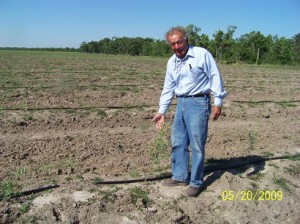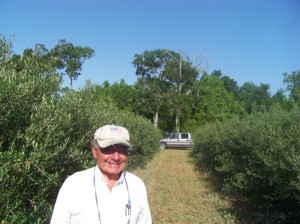Farmers… and you gardeners too: Listen up for just a few minutes and it could be the difference in the way you mix your martinis or something much more. But more especially, it could be a plan that could sweeten up your farm bank account according to experts this writer has visited within the recent few years. If you own a few acres that are idle and maybe a little equipment in the barn, olive farming doesn’t seem that difficult for the potential profits or gourmet treats that can be derived from an almost unlimited market for olive oil. Olive trees grow fast in this area, have minimal insect problems and are quite tolerant of weather condition; or at least more so than current crops and some trees we now raise.
Experts (in the past) said it couldn’t be done including the formidable school of agriculture at Texas A&M. However, there are serious challenges about that idea for olive crops are growing here and now. A new look by A&M and others have surprising promise. Climate conditions are important it seems, but our zone appears well suited.
Regions of Europe and the Mediterranean Sea area have been producing olives since before the birth of Christ. Some of those old trees still produce olives. The latitude of those places varies generally but the olive producing zones are roughly between twenty nine degrees and thirty six degrees. Houston, Texas for example, is around twenty nine degrees. Currently an interested investor from Australia is considering a major olive venture here.
Farming olives are in its infancy in our areas. But if estimated figures are even close to correct, gross dollar proceeds from only one acre of olives could yield $4500.00 if it brings only $l0 per liter. Other offers bring a price closer to twice that.
How long does it take to produce olives on your tree? It takes about as long as your favorite citrus tree or around four years. Occasionally olives will show up much sooner so it would depend a bit on the size of tree you planted, care and proper ground preparation. There are a number of sources to buy started olive trees for gardeners right here in Texas. A quick reference on the internet will introduce you to most places that will ship live plants directly to your home and prices range from around $l0 to $25. Large orders could be less especially from the huge plantations in California for serious olive growers. Again, it will depend on the size and number as to the cost. I got mine as a hobby gardener by calling Sandy Oaks Olive Orchard (near San Antonio, TX) 2l0 62l-0044.
Just south of Devers, Texas, there is an olive farm of considerable importance. Currently, Gino Venitucci has ten thousand olive trees growing and has planted six thousand more during February and March 2011. The pictures show his first planting of young trees when they are about knee high in November 2009. One year later the olive trees were shoulder high. Photos taken May 2011 see them at eight feet.
Mr. Venitucci first selected the clones or dwarf variety that can be easily harvested by a modified grape harvester machine. It is quite similar to a cotton picker or combines. On the other hand, larger trees he planted can be used and pruned to the acceptable height for machine harvesting. Ancient olive trees are much larger than his maximum eight foot olive trees but when not pruned are more labor intensive to harvest by hand.
Originally from Italy (now a Texan by choice and graduate of Texas A&M), Venitucci has traveled extensively in Spain, Greece, California and also South Texas. “Olive trees have grown in places with almost no soil; only rocks. Other places are rich and well drained farms,” he said. He further stated that land this close to the gulf breezes makes it highly unlikely to have a severe sustaining freeze lasting very long in duration. Cool nights and warm days in the fall, spring and summer makes it ideal for growing olives here he believes. Even a bit of winter snow helps, he said.
Our new Australian friend has spent several months here and elsewhere observing the potential profits for olive growing but he likes this area at this time. While we talked with him about the severe drought we have endured in recent months, he smiled and said, “Mate, where I come from we sometimes graze one cow to four thousand acres and have small trees like those I saw in South Texas. Take a look at your tall trees which are green and growing. It is not your current drought, it is the humidity. This is important though olives thrive in both. It is the irrigation to consider. Gino irrigates his farm with only a three quarter inch plastic pipe; bubbling its water maybe twice a week when dry. Real dry areas require more until they become full grown trees.”
When this writer planted twenty five olive trees on a well drained plot, I found no problem with the response. However, deer like the leaves but they don’t like the electric fence I put up. Of course, they got inside a couple times and kicked part of it down but now they seem to stay clear of the shock.
If it is your idea to join this new experiment as I have, it might allow you a unique bottle of your own label of pickled olives for the table or gifts to a special friend. But don’t expect to drop by the tree and sample a few unless you are particularly fond of green persimmons.
Again, please refer to the internet for the Texas Olive Oil Council and search “How to Pickle Olives”. Better yet, you can join this organization for possible updates on their website. It will give you dozens of recipes of which most are simple and easy to follow. Basically it is done with pickling salt and sometimes a weak solution of household lye. What could the successful commercial olive oil production mean to this country? First consider that in the USA we import about 90% of what we consume, so our current domestic production is only l0%. Therefore, imports from other countries account for the 90% but relating that to dollars spent; those imports approach a staggering 9 billion dollars annually. Put even a portion of that into our current agriculture economy would be an eye opener indeed for prospering farms. True, it is still somewhat experimental but so was gun powder a while back.
ESTIMATED PROFITS OF OLIVES GROWN HERE
From best sources available, the following are possible profits for the planting and growing olives for the domestic olive oil market.
ONE ACRE OF WELL DRAINED LAND WITH 500 TO 600 OLIVE TREES BY THE FOURTH YEAR YIELD: 4th year should produce 3 tons of raw olives per acre (3000KG) at minimum of l5% of olive oil will be about 450 liters of olive oil. Minimum sale is $l0 per liter or $4,500.00 gross per acre. However, the average in some areas is between $l8 to $20 per liter.
FIFTH YEAR EXPECTED YIELD; 5 tons per acre of raw olives yield 5000KG of olive oil @ l5% makes 750 liters. 750 liters at $l0.00 equals $7,500.
AFTER FIFTH YEAR PRODUCTION SHOULD YIELD: 7 tons per acre or 7000KG at about l050 liters @ $l0 equals $l0,050.00. Contracted harvest would be subtracted in each case.
These estimates might vary and peak production could skip a season due to unexpected atmospheric conditions or other possible interruptions as in all crops. Expert opinions should be solicited for verification. Usual farm equipment can be used but when it is time to harvest the farmer would most likely have a prearranged harvester owner who could come to your farm to harvest the olives with his combine and process the olive oil for an agreed portion of the oil.
Bob Jamison is a member of the Olive Oil Council of Texas. For more information contact the Council or jbobalong@yahoo.com.


